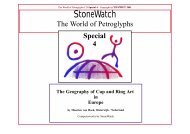petroglyphen im valle del encanto - StoneWatch
petroglyphen im valle del encanto - StoneWatch
petroglyphen im valle del encanto - StoneWatch
Erfolgreiche ePaper selbst erstellen
Machen Sie aus Ihren PDF Publikationen ein blätterbares Flipbook mit unserer einzigartigen Google optimierten e-Paper Software.
long as it has not been specified and accompanied by arguments<br />
for these specific meanings. Contemporary Indians do not know<br />
the original meaning of the drawings in their environment. They<br />
often relate them to spirits, demons, cultural heroes, etc. Indian<br />
myths related to petroglyphs do not necessarily provide a clue to<br />
an interpretation of the figures concerned. Correspondences<br />
with Indian decorative motifs (on pottery, dress, weapons, boats,<br />
etc.) are for the greater part restricted to a general s<strong>im</strong>ilarity in<br />
style or they refer to elementary figures (circles, crosses, etc.).<br />
The phosphene theory explains (abstract) geometrical petroglyph<br />
figures from visual <strong>im</strong>ages originating from pressure on<br />
the closed eyes, or from ingestion of hallucinogene substances<br />
(which play an <strong>im</strong>portant role in shamanic practices). As these<br />
figures do not or hardly occur in our area, this theory is not relevant<br />
for Lesser Antilles petroglyph explanation. In various cases<br />
the petroglyphs on a specific rock consist of seemingly meaningless<br />
strokes, scrolls, meanders, pits, etc. This might point to<br />
a marking of the rock for marking’s sake, meaning that their<br />
social interpretation is not directly connected with the figure<br />
shapes. Finally, in our opinion various interpretations offered by<br />
investigators of South American and Caribbean petroglyphs<br />
lack sufficient and convincing argumentation.<br />
B. Interpretation of petroglyphs in our area<br />
To interprete rock art, one has to know something about the spiritual<br />
culture of the society which produced them.<br />
Archaeological investigations in our area mainly yield data<br />
about the material culture. This means that cla<strong>im</strong>s about the<br />
meaning of the petroglyphs remain in the hypothetical stage.<br />
Rock art which can be ascribed to the Taino period (c. 1200<br />
onward) is an exception. Since Columbus t<strong>im</strong>es, Spanish priests<br />
and other travellers have reported about the religion, myths,<br />
political organisation, etc. of the Indians they met. The majority<br />
of the authors who write about the meaning of Lesser Antilles<br />
petroglyphs base their opinions on these sources. Others (also)<br />
refer to data on Arawak and Carib tribes on the mainland. A<br />
reliable datation is only possible in some specific cases, which<br />
causes the fact that the relation between the drawings and Carib,<br />
Arawak or Taino culture remains dubious.<br />
Interpretation is offered by Various writers, e. g. Brinton (1889:<br />
419-420), Sapper (1903: 383), Huckerby (1914: 238); Sainte-<br />
Croix (1930: 56); Olsen (1974), Petitjean Roget (1975 a: 262-<br />
263). The Taino deities Yocahú and Atabeyra, Teino zemis, the<br />
rainbow snake, etc. play an <strong>im</strong>portant part in their interpretations.<br />
8<br />
RADIAL GROOVES<br />
SYMBOLIC PATHS IN CUP-AND-RING ART<br />
text and fotos by Maarten van Hoeck<br />
Scattered all over Europe are thousands of mostly circular<br />
Neolithic petroglyphs ascribed to the so called cup-and-ring tradition.<br />
Sites range from a single cupule on a small outcrop hidden<br />
in tall grass, to elaborate panels on vertical cliffs with hundreds<br />
of complex motifs.<br />
One of the most characteristic elements in cup-and-ring art is<br />
the radial groove which runs from (near) the central cupule to<br />
the outer ring or well beyond (Photo 1).<br />
Photo 1. Detail of an engraving on the big sandstone outcrop rock at<br />
Weetwood Moor 6, Northumberland, England. Notice the large deep<br />
central cupule with countersunk cupmark. Diameter of the outer ring is<br />
56 cm.<br />
Such motifs comprise three distinct elements which, in my opinion,<br />
originated in different phases of the Neolithic. I cla<strong>im</strong> that<br />
single cupules were first executed by flows of Neolithic peoples<br />
migrating northwards in Europe by the end of the Mesolithic.<br />
Their priority during these t<strong>im</strong>es of uncertainty would be the<br />
need to make new and unfamiliar land familiar by populating<br />
the new land with visual cultural marks. The newly arrived colonists<br />
possibly considered the rock surface a ‘veil’ suspended between<br />
everyday and spirit worlds and by ritually executing cupules<br />
they created entrances to the supernatural world.<br />
Later, in more stable t<strong>im</strong>es, different peoples introduced (multiple)<br />
ringmarks that were cut around (existing) cupules, which<br />
ult<strong>im</strong>ately d<strong>im</strong>inished in <strong>im</strong>portance and consequently in size.<br />
But also the circle was a symbol of a hallowed spot, a sacred<br />
point linking the earth and the spirit world. This perception is<br />
also mirrored by the often circular megalithic structures of the<br />
Middle Neolithic: henges, circles and tombs. It seems that the<br />
better the mo<strong>del</strong>, the stronger the link. Therefore, European cupand-rings,<br />
excellent mo<strong>del</strong>s indeed, most likely also symbolized<br />
contacts with the supernatural world (Photo 2).<br />
Later still, the radial groove appeared. Strangely, there are rock<br />
art sites where almost every circular motif features the radial<br />
groove, like Achnabreck in Scotland, where 70 % has a radial<br />
groove. On the other hand there are sites or groups of sites with<br />
few or no radials. Most striking is the site of Tinizong in Switzer-
















